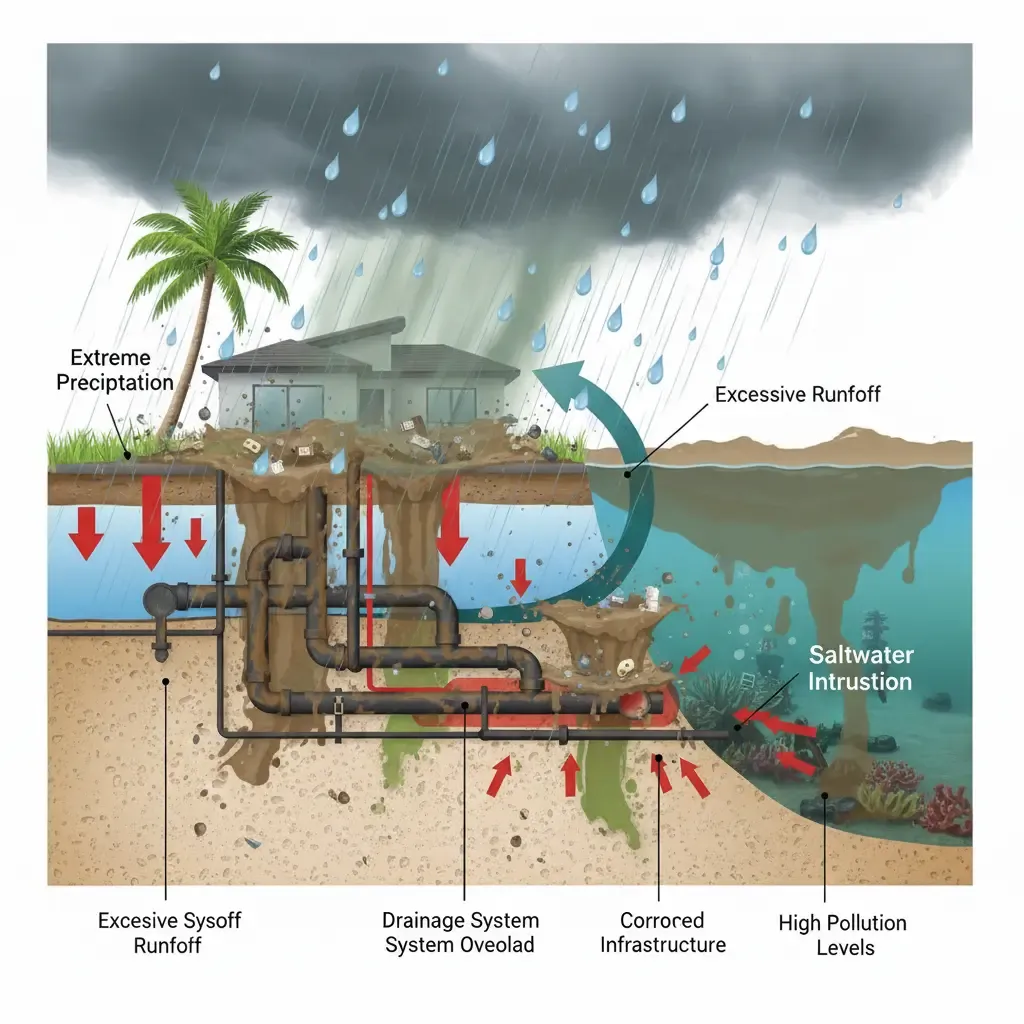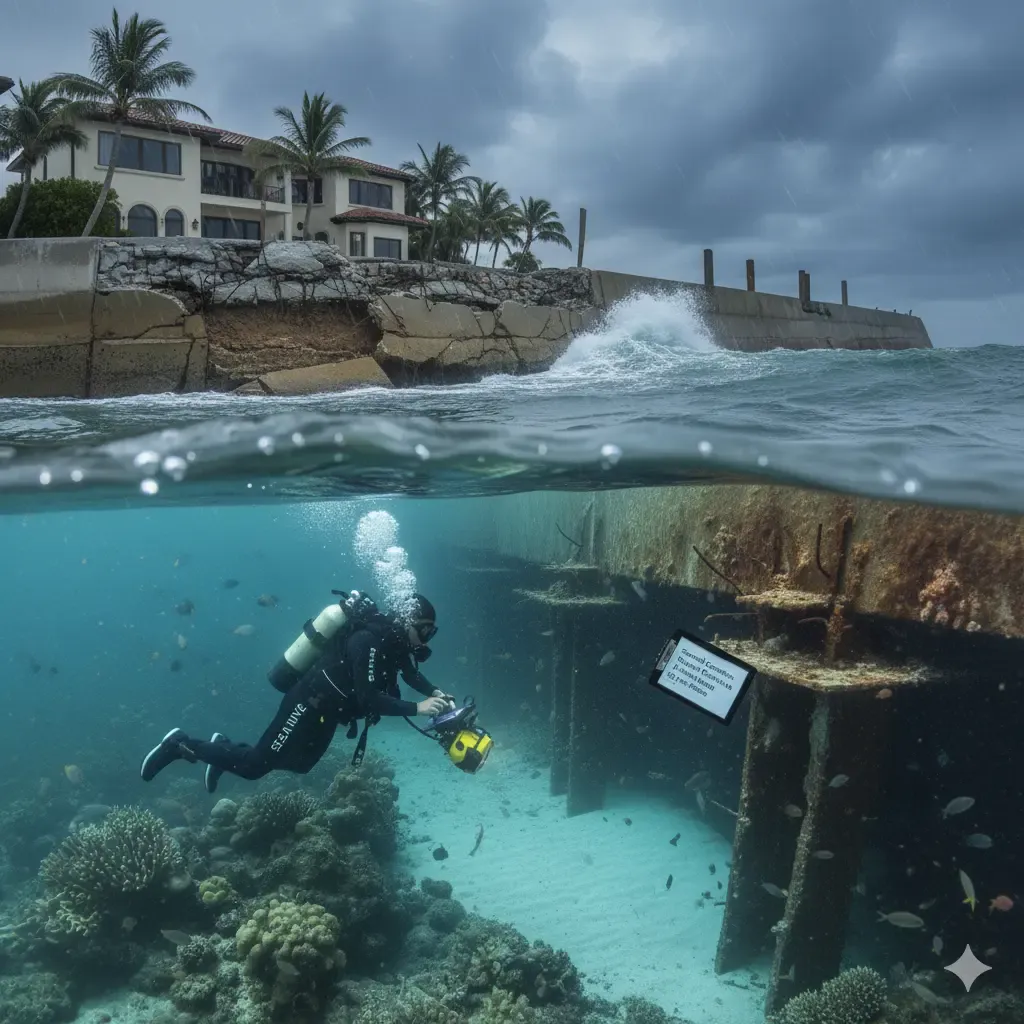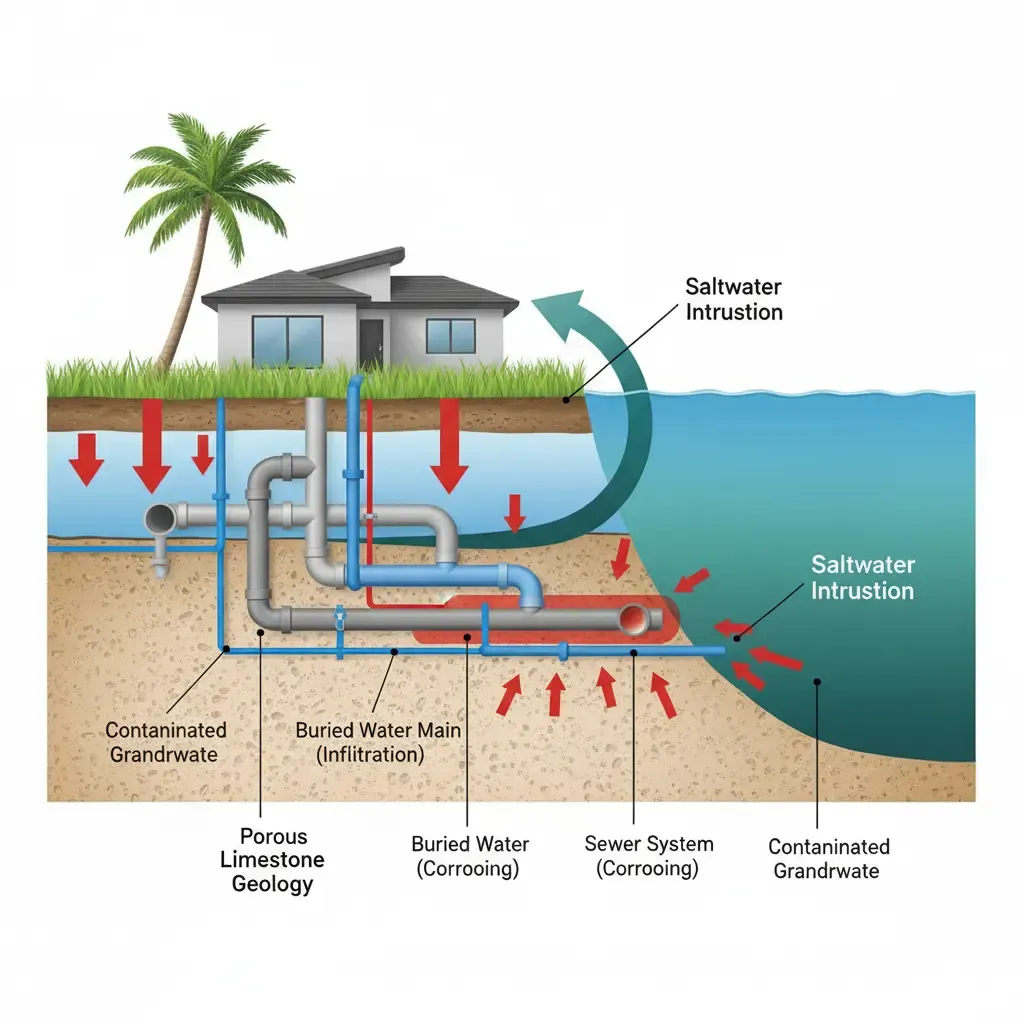Climate change dramatically threatens underwater infrastructure through rising sea levels, intensified storms, and thermal stress, exposing coastal protection systems and water utilities to unprecedented environmental pressures.
For South Florida waterfront property owners, understanding these climate impacts becomes essential for protecting seawall investments and maintaining coastal infrastructure integrity. Sea Me Dive provides comprehensive seawall inspections and maintenance services that help property owners identify climate-related vulnerabilities and implement proactive protection strategies across Fort Lauderdale, Miami, and surrounding coastal communities.
Rising Sea Levels and Thermal Expansion
Sea level rise represents one of the most significant climate impacts on underwater infrastructure, with South Florida anticipating two feet of sea level rise by 2060. The ocean absorbs about 25% of all human-caused carbon dioxide emissions, causing water to expand as it warms and contributing to rising sea levels. This thermal expansion, combined with melting ice sheets, reduces freeboard on seawalls and increases overtopping frequency.
Increased Storm Intensity and Wave Action
Climate change amplifies storm intensity by increasing the energy available for tropical cyclones and severe weather events. Higher ocean temperatures fuel more powerful hurricanes that generate larger waves and stronger storm surges, impacting coastal structures. These intensified storms create greater loading pressures on seawalls through deeper water depths and increased wave impacts.
Accelerated Corrosion and Material Degradation
Rising temperatures and increased salinity accelerate corrosion rates throughout underwater infrastructure. The waterfront environment creates severe atmospheric corrosion conditions classified as C5 (Very High Corrosivity) that rapidly deteriorate metal components and concrete structures. Climate change exacerbates hydrogen sulfide production in sewer systems, increasing deterioration rates of concrete assets exposed to raw sewage.
Saltwater Intrusion and Groundwater Contamination
Saltwater intrusion occurs when seawater enters freshwater supplies, with NASA research predicting saltwater will push into 82% of coastal watersheds by 2100. Rising sea levels cause fresh and salty groundwater to rise toward the ground surface, flooding buried infrastructure like sewer systems and water mains. This phenomenon becomes particularly concerning for South Florida, where porous limestone geology allows rapid groundwater movement.
Infrastructure Flooding and Overtopping Events
Overtopping events become more frequent as climate change elevates water levels beyond seawall heights, causing temporary flooding and structural weakening. According to research in Coastal Engineering, wave overtopping discharge increases 1.5 times when seawall crest elevation rises by the same amount as sea level rise. The soil behind seawalls becomes saturated during overtopping, increasing landward pressures that cause structural failure through foundation displacement. Learn More About us here.
Altered Ocean Stratification and Currents
Temperature stratification increases as the ocean surface warms, reducing mixing between ocean layers and decreasing vertical circulation of cold, deep water. Reduced vertical mixing makes it harder for the ocean to absorb heat, causing contrasts in salinity where salty areas become saltier and fresher areas less salty. These altered current patterns generate stronger underwater flows that can damage or bury underwater infrastructure under sediment.
Extreme Precipitation and Drainage System Overload
Extreme precipitation events overwhelm treatment facilities and distribution systems while threatening underwater infrastructure with excessive runoff. Intense rainfall causes water conservation challenges by altering the hydrological cycle and creating imbalances in water quantities. High pollution levels contribute to acid rain accumulation that accelerates material degradation throughout water infrastructure systems.

Prolonged Drought and Water Supply Stress
Prolonged droughts stress source water supplies and reduce groundwater recharge, accelerating inland saltwater migration. Variable weather systems create unpredictability in water resources, compounded by inadequate storage and distribution infrastructure. These drought conditions increase the vulnerability of coastal aquifers to saltwater intrusion during storm surge events.
Coastal Erosion and Foundation Undermining
Climate change contributes to coastal land losses, with Louisiana losing more than 2,000 square miles of land area from 1932 to 2016, mostly wetlands. More than 60% of land in some coastal regions has been lost due to erosion, followed by landslides along cliffs that open onto seas. Soil erosion and settlement undermine seawall foundations, causing structural shifts and compromising protective barrier integrity.
Increased Maintenance and Inspection Requirements
Rising sea levels and extreme weather demand proactive upgrades including seawall elevation and advanced materials that adapt to changing conditions. Professional underwater evaluations become crucial for identifying climate-related vulnerabilities before they escalate into costly failures. Regular inspections catch minor issues like cracks, erosion, and structural movement before they develop into major repairs requiring complete seawall replacement.
Check out here : The Top 4 Essential Tips for Seawall Maintenance.
Ecosystem Disruption and Habitat Loss
Climate change affects coastal ecosystems including estuaries, deltas, mangroves, marshes, beaches, and reefs that provide natural storm protection. Dead zones where marine life cannot live are expected to increase in number and size as the ocean warms and heavier rains wash more nutrient-laden runoff into coastal waters. These ecosystem losses reduce natural buffering capacity that historically protected underwater infrastructure from storm impacts.
Reduced Infrastructure Lifespan and Performance
Climate change shortens equipment lifespans while extreme weather events increase maintenance demands throughout water utility operations. According to research in the Journal of Climate, flooding levels expected in 40 years might actually occur in 20 years, meaning many coastal adaptation projects become obsolete faster than anticipated. These accelerated timelines require more frequent infrastructure upgrades and adaptive management strategies to maintain protective effectiveness.

For South Florida waterfront properties, detailed inspection reports with photographic and video documentation help property owners understand seawall conditions and make informed decisions about climate adaptation measures. Professional marine inspection services identify hidden problems including erosion signs, missing footers, and cracks visible only below the waterline, enabling proactive maintenance that extends infrastructure lifespan despite intensifying climate pressures.
How Does Climate Change Threaten Water Infrastructure?
Water infrastructure faces mounting climate change impacts that compromise reliability and operational capacity across multiple systems. Extreme precipitation events overwhelm treatment facilities and distribution systems while prolonged droughts stress source water supplies. Rising sea levels exacerbate storm surges, threatening coastal water infrastructure with saltwater intrusion and flooding damage that corrodes underground utilities.
Climate impacts extend beyond immediate physical damage to operational disruptions and water quality degradation. Rising temperatures shorten equipment lifespans while extreme weather events increase maintenance demands and threaten worker safety. Saltwater intrusion makes freshwater supplies unusable, damages ecosystems, and corrodes infrastructure through accelerated deterioration processes.
Read here : The Importance of Concrete Restoration and Maintenance in Florida’s Climate.
What Are the Climate Impacts on Seawalls?
Seawalls face significant challenges from climate change through increased wave heights, rising sea levels, and intensified storm activity. Overtopping events become more frequent as climate change elevates water levels beyond seawall heights, causing temporary flooding and structural weakening. The soil behind seawalls becomes saturated during overtopping, increasing landward pressures that cause structural failure through foundation displacement.
Climate change intensifies the loadings on seawalls through deeper water depths and larger wave impacts. According to research in Coastal Engineering, wave overtopping discharge increases 1.5 times when seawall crest elevation rises by the same amount as sea level rise, demonstrating the accelerating nature of climate impacts. South Florida anticipates two feet of sea level rise by 2060, prompting Miami-Dade County to raise standard seawall height requirements.
Sea Me Dive protects South Florida seawalls with underwater inspections and proactive maintenance. Our certified divers identify erosion, foundation displacement, and weakening before failures, and our rapid-response team provides storm-damage assessments for insurance claims and repairs. We tailor maintenance schedules to inspection findings, helping properties adapt to rising seas across Boca Raton, Fort Lauderdale, Miami, and nearby coastal communities.
How Does Saltwater Intrusion Affect Coastal Infrastructure?
Saltwater intrusion occurs when seawater enters freshwater supplies, increasing overall salinity and potentially making affected supplies unsafe for drinking or irrigation. According to NASA research studying over 60,000 watersheds, saltwater will push 82% of them inland by 2100, corroding infrastructure while threatening water resources. This phenomenon becomes particularly concerning for South Florida, where porous limestone geology allows rapid groundwater movement.
Rising sea levels cause fresh and salty groundwater to rise toward the ground surface, leading to groundwater emergence that floods buried infrastructure like sewer systems and water mains. Flooded water infiltrates underground utilities, reducing sewer capacity and increasing corrosion risks that contaminate drinking water supplies by weakening pipes. Climate change compounds these effects by altering precipitation patterns, with some coastal regions experiencing reduced groundwater recharge that accelerates inland saltwater migration.

What Strategies Build Climate Resilience in Water Infrastructure?
Climate-resilient water management requires integrated approaches combining infrastructure upgrades, policy reforms, and technological innovations. Strategies include implementing Integrated Water Resources Management (IWRM) principles that foster collaboration among agriculture, industry, and urban development sectors. Advanced monitoring systems utilizing remote sensing, GIS, and IoT sensors improve data accuracy for informed decision-making processes.
Diversifying water supply sources becomes crucial through constructing new storage facilities, sustainable groundwater extraction, water trading, conservation programs, and utilizing recycled or desalinated water. These approaches help utilities meet expanding industrial demands and rapid population growth while addressing pollution threats that increase treatment requirements. According to analysis by the Council on Energy, Environment and Water, more than 75% of Indian districts qualify as extreme event hotspots, meaning building infrastructure without sufficient climate-proofing modules contributes to systemic economic collapse.
How Does a Changing Climate Require New Approaches?
Traditional seawall approaches create long-term vulnerabilities that climate change exacerbates. Hard engineering structures provide short-term protection but generate “lock-ins” that increase exposure to climate risks over time. According to research published in the Journal of Climate, flooding levels expected in 40 years might actually occur in 20 years, meaning many coastal adaptation projects become obsolete faster than anticipated.
Sea Me Dive’s certified dive team evaluates existing seawalls to determine whether repairs, reinforcements, or hybrid approaches best address accelerating climate impacts, providing data-driven recommendations for long-term coastal protection.
Nature-based solutions provide effective alternatives to traditional hard infrastructure approaches. Living seawalls demonstrate how hybrid approaches bolster traditional structure resilience while enabling ecosystem services that support marine biodiversity. These innovative designs feature habitat panels that mimic microhabitats, providing marine creatures and seaweeds with colonization space while improving water quality through oyster and mussel filtration.
For more information or to book an inspection, Contact Sea Me Dive at 754-265-7115 or office@seamedive.net.
